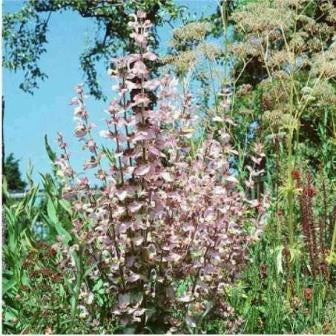CLARY SAGE - kr32
Have a question?

CLARY SAGE - kr32
Dettagli
Scientific name: Salvia officinalis
Family: Lamiaceae (formerly Labiatae)
Brief history and botanical notes on the plant
Salvia officinalis L. or domestic sage, is a 20-40 cm tall suffrutix. It is characterized by:
• Woody stem, branched at the base and with patent hairs.
• Lanceolate leaves, tormenting gray in colour, with an aromatic smell.
• Flowers grouped in whorls of 5-10 flowers, the lower ones are surrounded by a pair of bracts. The corolla is violet. Parts used: The leaves.
• Flowering: From March to September Depending on the altitude, exposure and frequency of cutting, the flowering period ranges from May to September.
Pedoclimatic needs
It requires sandy-loam soil, well drained with full sun exposure, and well ventilated to avoid water stagnation.
Cultural care
Only when planted are regular watering and light trimming.
At maturity only emergency watering, and pruning at vegetative growth, to complete the preparation. They can be lowered in the autumn period or at vegetative growth by cleaning the dry or damaged part.
Propagation
Seed: In trays with a mixed sandy soil (50% silica sand, 50% Sowing soil), spring is the optimal period, particular attention is required when planting given the small size of the seed, daily watering, constant humidity 60- 65%, constant temperature 18°C. The seed has a low germination rate so it is advisable to increase the number of seeds planted. The ideal condition is sowing under tunnels with basal (floor) heating and a nebulizer system for constant humidity (mist).
In the May-June period, the new seedlings are transplanted (h.: 2-3cm);
This method is preferable for those who practice the Biodynamic method, because it guarantees the variability of the genotype.
Semi-woody cutting: It is carried out in spring. The cuttings must be 8-10 cm long, taken from the apex of healthy and vigorous 2-3 year old plants. They must be planted for at least 2/3 of their length in a mixture of peat and sand, taking care to eliminate the leaves of the part that will go underground, and kept in a cool greenhouse (about 18°C) until they are rooted (a months). They will be transplanted to their permanent location the following spring.
Division
It is carried out in spring (March – April) on young 1-2 year old plants. For a few months they will be managed in a container in a cool shaded place, and then transplanted into the open field by June.
The planting density must be 4 plants/m2.
Fertilizers
Bottom fertilization with well composted manure. Being a spontaneous and very rustic plant, it does not require particular periodic fertilization.
Processing
Based on the planting density (recommended 4-5 plants m2), in the first three years after planting it requires weeding on the row for weed management, with a manual weeder. On the row avoid the use of a router unless combined with a previous pass of a depth ripper.
Adversity
In the open field, as the plant is very rustic, it is also resistant to the main cryptogamic diseases. If well-made plants have been planted, avoiding water stagnation and too dense planting densities, mild attacks of powdery mildew and downy mildew rarely occur.
In containers, however, there is an increase in plant diseases due to the exponential growth in the production of aromatics in containers of rosemary, sage, thyme, mint:
Parasitic Disease Biological defense
Fungal diseases
White sore Oidium sp. Sulfur, Ampelomyces quisqualis (*)
Downy mildew Peronospora lamii Rameici
Insects
Aphids Different species Pyrethrum/horsetail macerate
Thrips Different species Pyrethrum
(*) In the process of being registered
Production, collection and conservation
Upon contact, the whole plant exudes a pleasant and persistent aroma.
The aromatic properties are given by the essential oil which has a very complex chemical composition whose main compounds are: alpha and beta-thujone, camphor and 1,8-cineole, which are responsible for its characteristic aroma of the plant.
However, only the leaves and flowers are collected, from which the essential oil is also obtained.
For drying it is better to use the old basal leaves taken before flowering, as they are richer in aroma. They are left to dry in shady and ventilated rooms for approximately 20-25 days.
Food uses
Sage is the most used aromatic plant in the kitchen, for seasoning meats and roasts, soft cheeses, mushrooms, fillings, soups and the flowers can be added to salads.
In medicine
Its bactericidal, diuretic and emmenagogue properties have been known since the Romans.
As Rudolf Steiner claims (course for Doctors held in Dornach from 31/12/1923 to 2/1/1924), the tannin content is of fundamental importance (Editor's note: approximately 5% of the dried leaves), which allows it to act on the body astral by stimulating the activity of the Ego in the Neuro-Sensory system.
In particular it is useful for the treatment of asthma.
Biodynamics
Special care is required during the planting phase with light fertilization with mature biodynamic compost.
Treat with preparation 500, before proceeding with planting and then at the beginning of the vegetative phase. Use preparation 501 at least twice before harvesting to enhance the aromas and aromatic principles



